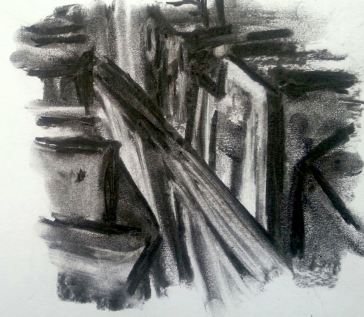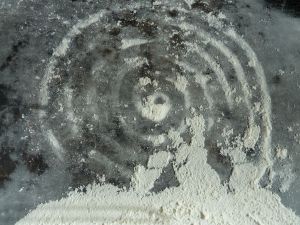Ashmolean, Oxford
26th March – 31st August 2015
The exhibition of Great British Drawings at the Ashmolean showcases some of the very best British drawings and watercolours selected almost exclusively from the Ashmolean’s collection, one of the largest of its kind in the world. The exhibition documents over three Centuries of British drawing history from 1650 to the end of the 20th Century. Britain was apparently rather cautious in its ability to establish Art Academies, unlike European counterparts such as France and Italy, with art education only starting to be formalised in the 17th Century. Once formed however, Art Academies gave artists a platform from which to explore the medium of drawing, allowing experimentation and rejection of established norms. This exhibition follows the evolution of drawing in Britain from 1650 with beautifully crafted portraits in chalk, bold gestural studies in pen and ink and the introduction of watercolour, a medium that blurs the boundaries between drawings and paintings.
I used this exhibition to specifically look at some of the techniques that I have been practising on this course so far, namely using mark making to depict form and shadow. I was particularly interested in looking at cross-hatching and stippling effects, and, with the approach of assignment 1, was on the look out for mixed media ideas. I took a sketchbook and B pencil in with me to draw but unfortunately photographs were not allowed and most of the images do not exist in a public format so in this blog I am unable to show the originals!
Many early works were done in chalk or charcoal usually on a coloured ground. This provided the midtone with the darks marked in using a variety of controlled cross-hatching or parallel lines to depict both form and shadow. Highlights were added using white chalk. Some smudging evident but the mark making appears careful and considered and suggests diligence and patience in application rather than quick gestural marks.

Sir Godfrey Kneller
Henry Aldrich, Dean of Christ church, 1696
I have tried to capture the varying intensity of crosshatching that makes up the chin and jaw of Kneller’s Henry Aldrich, Dean of Christ Church. The exhibition catalogue describes these marks as etching-like. Such a disciplined approached to drawing is also seen in Boswood’s Thigh and the right arm of Michelangelo’s David by George Richmond.

George Richmond
‘Boswood’s Thigh’ and the right arm of Michelangelo’s ‘David’, 1828
I struggled (especially with the lack of a pencil sharpener) to mimick the delicay and accuracy of the lines used to delineate the shadow and the form of the knee of the anterior view of Boswood’s thigh (apparently we don’t know who Boswood was).
More gestural marks appear to have been reserved for ink and wash, certainly in the Eighteenth Century at least.

Sir Joshua Reynolds
Study of Charity, c.1778
Here I have tried to capture the outlines marked in ink from Joshua Reynolds’s Study of Charity. My cross-hatching and shading indicates areas of wash depicting shadows and forming a 3-D image. The shadow also allows the second child to receded behind the nearest who is almost entirely highlighted.
Whilst looking for interesting mixed media components of the exhibition I came across The Valley with a Bright Cloud by Samuel Palmer (1825). He used pen and brush with sepia ink mixed with gum arabic. Whilst not strictly mixed media, the thicker brushed lines stood up impasto-like from the paper adding texture to the scene. I didn’t manage to sketch this in any useful form, but the idea of drawing with a raised surface was one to file away and perhaps use one day!

Augustus John
Standing draped figure, c.1909
I was particularly taken by Standing Draped Figure by Augustus John (c. 1909) in graphite on paper. The outline of the female form is depicted, with some shading to suggest form, and then overlaid are the most wonderful drapes, depcited by gesteral lines showeing the fall of the material. The direction of the lines further enhance the form of the figure.

Harold Gilman
Seascape: breaking Waves, 1917
After my rather painful experience in stippling, I was interested to come across Seascape: Breaking Waves but Harold Gilman (1917) in which Romney Marsh is depicted entirely in layers of mark-making which in the words of Colin Harrison, Senior Curator of European Art, ‘merge sky and sea into a whole composed of elements’ ‘creating a pattern of marks which while evoking a seascape, tend toward the abstraction of nature’.
The exhibition, whilst generally chronological, is arranged across three galleries in five sections each considering an important era in the development of drawing. You only have to stand in the middle of the first section ‘Likeness, Sensibility and Vision’ and cast your eyes around 360 degrees to appreciate how the art of drawing has changed over the time. Other sections include ‘Ruskin and the Pre-Raphaelites’ showcasing work produced with the Ruskian idea of replicating nature in all its truth; and ‘Diversity and Conflict’ focusing on artist’s work from the 20th Century, the era of Modern Art, culminating in a very powerful image ‘Salman Rushdie’ (1993) by Tom Phillips (b. 1937). Mark-making becomes much bolder by the end if the 19th Century and throughout the 20th Century.

David Bomberg
Evening in the City of London, 1944
Charcoal wasn’t allowed in the gallery for obvious reasons, and pencil didn’t really manage to capture the power of thick charcoal but I did this brief sketch at home of part of the arial view of London in Evening in the City of London by David Bomberg (1944) from a post card!. Its not a very good rendition but it does indicate the bold sweeping lines of charcoal that became more evident through the century.
Reflections
There is a time and place for delicacy in mark making and just because I don’t like the process of doing it doesn’t mean that I can’t use it. I should try and vary my marks more even though I still found the expressive charcoal lines more to my taste .
The pen and wash may be useful media for assignment 1, however I have no experience in these so would need to practice. I need to experiment with some other mixed media ideas too.
Always take a pencil sharpener with you!

